Workplace injuries can have severe consequences for employees and employers alike. When an accident occurs on the job, questions often arise regarding who is responsible for medical expenses, lost wages, and other damages.
Employers, in many cases, bear some level of liability for injuries that occur in the workplace. However, determining liability is not always straightforward, as it depends on several factors, including negligence, compliance with safety regulations, and the specifics of the employment arrangement.
This article will explore employer liability in workplace injury cases, the legal framework governing these claims, and how businesses can mitigate risks. Understanding these aspects is crucial for both employees seeking compensation and employers aiming to prevent costly legal disputes.
Ensuring Compliance with OSHA and Workplace Safety Regulations
A significant aspect of employer liability is compliance with the Occupational Safety and Health Administration (OSHA) regulations. Businesses are legally required to provide a safe working environment, which includes identifying and mitigating potential hazards, ensuring proper employee training, and maintaining safety equipment.
Failure to comply with these regulations can result in severe consequences, including OSHA citations, fines, and increased liability in injury claims. Employers facing such citations must take immediate corrective actions to avoid further legal repercussions.
If you’re dealing with an OSHA citation, visit https://www.legacymarksafety.com/safety-expert-witness to get in touch with a professional who can help navigate the complexities of workplace safety compliance.
Taking proactive steps to ensure compliance not only protects employees but also minimizes the risk of litigation. Implementing regular safety audits, training programs, and emergency preparedness measures can significantly reduce workplace hazards and liability exposure.
The Legal Basis of Employer Liability
Employer liability in workplace injury cases is often based on negligence, workers’ compensation laws, or third-party liability claims. The most common legal principles that determine employer responsibility include:
- Negligence – If an employer fails to provide a safe working environment and an injury occurs as a direct result, they may be held liable. Negligence can include failing to fix known hazards, inadequate employee training, or improper safety protocols.
- Workers’ Compensation – In many jurisdictions, workers’ compensation laws protect employees by ensuring they receive medical care and wage replacement after a workplace injury. These laws typically prevent employees from suing their employer unless gross negligence or willful misconduct is involved.
- Vicarious Liability – Employers can also be held responsible for the actions of their employees. If an employee causes an accident while performing job duties, the employer may be liable under vicarious liability principles.
- Third-Party Claims – In some cases, workplace injuries involve third parties, such as equipment manufacturers or subcontractors. Employers may share liability in such claims depending on their level of oversight and responsibility.
Understanding these legal concepts is essential for both employers and employees when determining fault in workplace injury cases.
Common Causes of Workplace Injuries
Workplace injuries occur due to various factors, ranging from hazardous working conditions to human error. Some of the most common causes include:
- Slip and Falls – Wet floors, uneven surfaces, and poor lighting contribute to slip-and-fall accidents.
- Machinery and Equipment Malfunctions – Faulty equipment or improper usage can lead to severe injuries.
- Repetitive Stress Injuries – Jobs requiring repetitive motions can cause long-term musculoskeletal disorders.
- Exposure to Harmful Substances – Chemical exposure, asbestos, and toxic fumes can result in serious health conditions.
- Overexertion and Fatigue – Jobs requiring physical labor may lead to injuries due to exhaustion or improper lifting techniques.
Employers must identify potential hazards and implement safety measures to prevent workplace injuries.
How Employers Can Reduce Liability
Employers can take several steps to minimize liability and protect both their employees and their business. These include:
- Implementing Safety Policies – A well-documented safety policy sets clear guidelines for preventing accidents and handling emergencies.
- Providing Regular Training – Employees should receive regular training on safety procedures, equipment usage, and emergency response protocols.
- Conducting Workplace Inspections – Routine safety audits can help identify hazards before they cause harm.
- Maintaining Proper Documentation – Keeping records of training programs, safety inspections, and injury reports can help defend against liability claims.
- Ensuring Proper Workers’ Compensation Coverage – Having adequate workers’ compensation insurance ensures that employees receive benefits while protecting employers from lawsuits.
By proactively addressing workplace hazards, employers can significantly reduce the risk of injuries and legal claims.
When Employers May Not Be Liable
While employers have a legal duty to provide a safe work environment, there are situations where they may not be held liable for workplace injuries. These include:
- Employee Misconduct – If an employee acts recklessly, disregards safety protocols, or engages in prohibited activities, the employer may not be responsible for the resulting injuries.
- Independent Contractors – Employers are typically not liable for injuries sustained by independent contractors unless they were negligent in providing a safe working environment.
- Acts of Nature or Unforeseeable Events – Injuries caused by natural disasters or unforeseeable events may not result in employer liability unless negligence played a role.
Understanding these exceptions can help employers and employees navigate workplace injury claims effectively.
All in all, employer liability in workplace injury cases is a complex issue that depends on multiple factors, including negligence, regulatory compliance, and the circumstances surrounding the injury. Employers must take proactive measures to ensure workplace safety, comply with OSHA regulations, and implement comprehensive training programs to minimize liability.
Employees, on the other hand, should be aware of their rights and the legal avenues available to them in case of an injury. By fostering a culture of safety and accountability, businesses can protect both their workforce and their financial stability.










